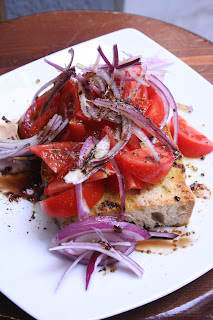Green Winery and Blue Skies Ahead
I just visited the Salcheto Winery in Montepulciano,
Tuscany.
One of the great things about living in Italy is hosting
friends, family, and friends of friends. It gives you a great excuse to revert to your days as a tourist and shamelessly photograph everything.
In this case,
my friend's husband offered to show his winery to an out of town guest and
invited me to come along. Annie and I hit it off immediately. We both love to eat and drink!
 |
|
Salcheto Winery in Montepulciano, Tuscany began an
initiative
in 2009 to become Carbon Free.
|
Would I say no to such a nice invitation?
Do you see how blue the sky is in these photos?
Did I mention the winery is near one of my favorite cheese
makers in Tuscany?
The Salcheto winery has gotten a facelift recently. But
don't think of this as cosmetic surgery. Salcheto has restructured itself from
every aspect to have as little impact on the environment as possible.
Natural
light and gravity are two key factors to using less energy in the cellars.
 |
| Light receptors on the patio that double for pumping wine. |
 |
|
Ron shows how the light receptor works
and doubles as a route to pump wine using
the
force of gravity to save energy.
|
 | ||||||
| The cellar's Slavonian oak tanks lit naturally from above. |
Salcheto produces several wines, in addition to their Rosso
di Montepulciano and Vino Nobile di Montepulciano, they make a Chianti Colli
Senesi, an IGT, a Rosato, a dessert wine, and grappa.
Worth noting: their IGT called Salco Evoluzione. The winery
decided to conduct an experiment, bottling 50% of a specific wine using the
classic cork method, and the other 50% with bottles sporting modern screw caps.
Consumers can buy one of each and compare the evolution of the wines,
even sharing their notes on Salcheto's website. I'll be trying these soon and
reporting my notes with a blog entry.
 |
| This is the coolest concept ever. I'm a sucker for brilliant packaging. |
PS- If you don't know the difference between Nobile di Montepulciano and Montepulciano di Abruzzo, you are not alone! Many people
confuse the two wines since they both have the name Montepulciano in their
titles. What's the big difference? Quite a lot.
Rosso and Nobile di Montepulciano are wines made of the
Sangiovese grape in the wine growing area of Montepulciano, in Tuscany. On the
other hand, Montepulciano di Abruzzo is made of a grape called Montepulciano
grown in Abruzzo.
 |
| Annie upon arrival at Cugusi. |
...No wine tasting is complete without a little cheese,
so we headed down the road to a fantastic cheese maker called Cugusi. Like many
in the Pienza area, Cugusi specializes in cheese made with sheep's milk, called
pecorino. Pecorino comes in several sizes and textures, depending on how long they are aged, where they are aged, and what, if anything, is added to the rind during aging.
 |
| Pecorino can be aged in caves, wrapped in walnut leaves or covered in ashes, among other methods. |
After tasting about ten different types of Pecorino
cheese, I bought a hunk of their Candido, seen on the left in above photo. Imagine a brie
made with sheep's milk. Need I say more?
 |
| Pecorino in Ceneri, Ashes |
To complete our day, we decided to pay homage to the source of pecorino's glory, Pienza.
This small town is highly elevated, but the town itself is flat and pretty small, offering amazing views and an effortless walk for anyone who's filled up on cheese.
 |
|
A side street in adorable Pienza.
|
Keep in mind, on most days you will smell a faint aroma of pecorino in the breeze that fills the streets of Pienza.
Pienza has often been referred to as ideal and even Utopian, not because of her pecorino breezes, but for a combination of careful city planning and natural environment created by Pope Pius II.
 |
| Love Street, Pienza. |
 | |
| A store window creatively displays pecorino. |
 |
| Let us give thanks for the pecorino. Amen. |
QUICK AND EASY TUSCAN ANTIPASTO OR DESSERT:
- Slices of pecorino toscano semistagionato or stagionato.
- Salcheto's millefiori honey
- Serve room temperature.
 |
Or try this fantastic recipe from Food52:
Sformatino di Pecorino al Miele
|




Congrats for this captivating vacation! It was a good choice. This region has a lot to offer.
ReplyDelete